To picture this farm, imagine some dark blobs dangling high up in a tree.
Each blob can reach “about soccer ball size,” says evolutionary biologist Guillaume Chomicki of Durham University in England. From this bulbous base, a Squamellaria plant eventually sprouts leafy shoots and hangs, slumping sideways or upside down, from its host tree’s branches. In Fiji, one of the local names for the plant translates as “testicle of the trees.”
Some Squamellaria species grow in clusters and teem with fiercely protective ants. As a young seedling blob plumps up, jelly bean–shaped bubbles form inside, reachable only through ant-sized doorways. As soon as a young plant cracks open its first door to daylight, “ant workers start to enter and defecate inside the seedling to fertilize it,” Chomicki says.
The idea that ants tend these plants as farmers gave Chomicki one of those surprise-left-turn moments in science. In a string of papers published since 2016, he and colleagues share evidence for the idea that the Philidris nagasau ants may be the first known animals other than humans to farm plants. (The other known insect farmers cultivate fungi.) Chomicki’s latest paper, in the Feb. 4 Proceedings of the National Academy of Sciences, reports that ants planting seeds of their blobby crop make trade-offs, going for full sun and maximizing the rewarding, sweet flowers rather than planting in the shade, where plants would have higher nitrogen.
Until Chomicki’s work, biologists accepted only three groups of fungus-farming insects as achieving the essentials of full agriculture and so rivaling human efforts. Select types of beetles, termites and ants each tamed different fungi, tending their much-needed food crop from sowing to harvest.
Humans didn’t farm any food before roughly 12,000 years ago as far as we know. Insects started much earlier. Even leaf-cutter ants, relative newcomers to farming, have been growing their specialized crops for about 15 million years.
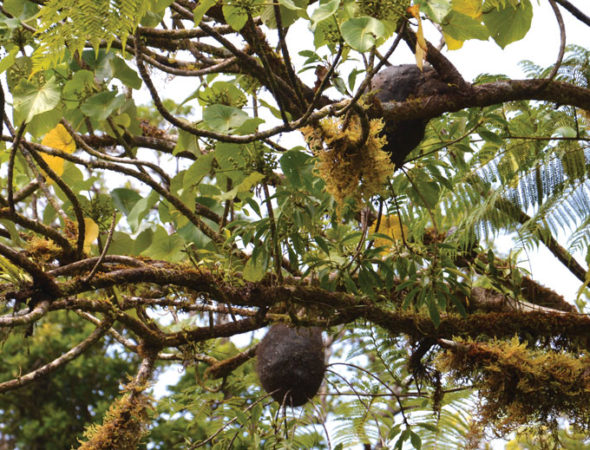 The dark lump above, a Squamellaria plant, is not part of the tree it hangs from. It’s a member of the coffee family, cultivated on sunny branches as part of lumpy plantations created by Philidris nagasau ants.G. Chomicki
The dark lump above, a Squamellaria plant, is not part of the tree it hangs from. It’s a member of the coffee family, cultivated on sunny branches as part of lumpy plantations created by Philidris nagasau ants.G. Chomicki 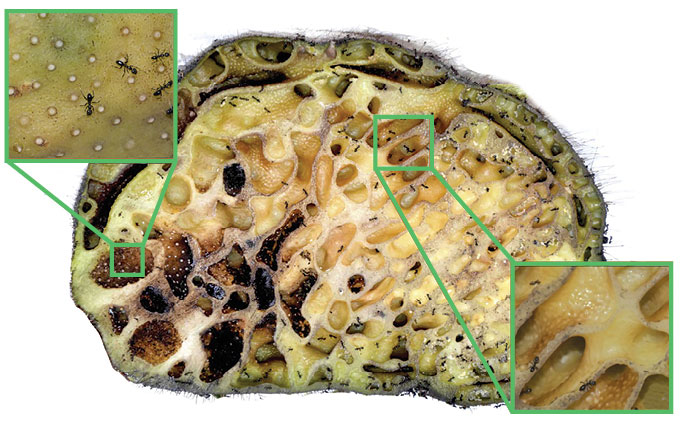 Ants find homey cavities in the base of a Squamellaria blob (cross section shown). The plant naturally forms both knobby-walled zones (left inset) perfect for latrines and smooth-surfaced living spaces (right).G. Chomicki
Ants find homey cavities in the base of a Squamellaria blob (cross section shown). The plant naturally forms both knobby-walled zones (left inset) perfect for latrines and smooth-surfaced living spaces (right).G. Chomicki
To compare agriculture in insects and humans, entomologists, archaeologists and other specialists have held three gatherings in the last six years searching for principles and perhaps some practical advice. (A press fellowship from the Konrad Lorenz Institute for Evolution and Cognition Research paid for me to attend the 2019 symposium in Klosterneuburg, Austria.)
The fungus farms of leaf-cutter Atta ants and their close relatives invite comparisons with human farms. Both kinds of farmers do things that look unsustainable, such as growing single crops at a vast scale and applying pesticides. Yet the ants have managed to persist for millions of years.
Biologists have long mused about whether we humans can make our farms more robust by imitating the practices of ants and other small farmers. That question sounds especially pertinent when human agriculture is heading for big challenges, such as predicted population growth and climate change.
How to learn from ancient farmers isn’t an easy question though. Evolution hones by competition, not design, so there are some goofy tactics out there among the insect marvels. Now is a great era for such discussions, because researchers are paying more attention to smaller, odder insect farms. Scientists have barely begun to explore the ways beetles grow fungi, or the quirks of the ants that grow their own plants.

Trustworthy journalism comes at a price.
Scientists and journalists share a core belief in questioning, observing and verifying to reach the truth. Science News reports on crucial research and discovery across science disciplines. We need your financial support to make it happen – every contribution makes a difference.
Subscribe or Donate Now
Farmers vs. not-quites
Just what counts as true farming makes a fine starter for impassioned conversations among scientists. (Perhaps the fungi are farming the ants, one longtime expert argues.) In this article, true agriculturists are defined as those who habitually plant a crop, tend it, harvest it and depend on its success.
Plenty of other creatures — social amoebas, a marsh snail, a damselfish, for instance — have evolved ways to encourage food to appear where and when they want it. Impressive as those feats are, plenty of scientists don’t consider those lifestyles full-on agriculture.
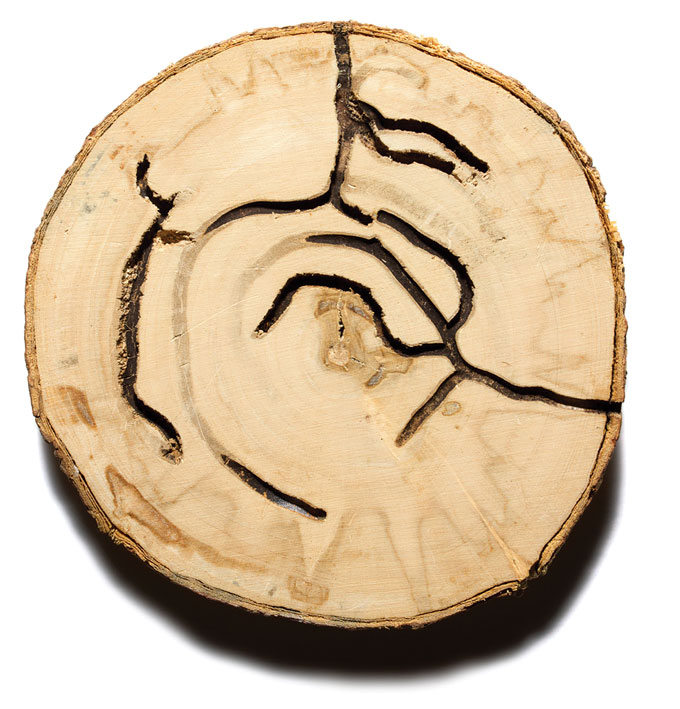 Ambrosia beetles dig tunnels into trees for their fungus farms. The fungi take in nutrients from the tree, and become beetle chow. J. Hulcr
Ambrosia beetles dig tunnels into trees for their fungus farms. The fungi take in nutrients from the tree, and become beetle chow. J. Hulcr
Several thousand species of the group called ambrosia beetles make up the biggest of the three insect groups that humans deign to call true farmers. Florida’s avocado growers have become urgently interested in the invading redbay ambrosia beetle (Xyleborus glabratus) because it raises a fungus that can destroy the innards of avocado trees. Fungus farming has evolved independently at least 11 times among these beetles, says forest entomologist Jiri Hulcr of the University of Florida in Gainesville. A few ambrosia species tunneling into trees bring along a fungus that can digest wood’s tougher molecules. Most ambrosia fungal farms, though, are just scavenging nutrients in the dying tree. Still, the fungus gets nutrients, then the beetles eat the fungus.
A similar outsourcing of digestion feeds a second group of true farmers, around 330 species of termites in the subfamily Macrotermitinae. The termites collect bits and scraps of dead plant material and feed it to a fungus coddled in cozy caves dug out by the termites. Then the tiny farmers feast on the fungus.
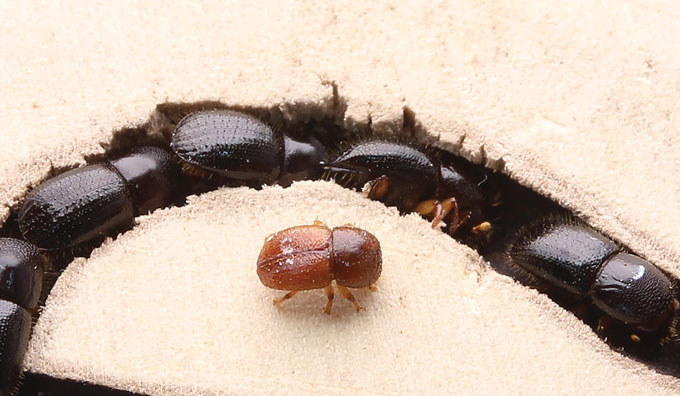 Within a tunnel, Euwallacea beetles raise daughters that mate with their lone, blind brother (light brown), then set off to create more tunnel farms.J. Hulcr
Within a tunnel, Euwallacea beetles raise daughters that mate with their lone, blind brother (light brown), then set off to create more tunnel farms.J. Hulcr
The showiest of these termites are the African Macrotermes, which are master builders as well as farmers. Above ground they create mounds of hard, red-orange mud several meters high and as jagged as the Alps. The mini-mountains are porous, able to channel airflow and manage temperatures for the fungus caves within. The farm feeds the offspring of a king and outsize queen, which, in one species, is reported to produce some 20,000 eggs a day.
Atta girls
The most famous big-scale insect farmers invented their own Kansas. Fungus-farming ants started out modestly in agriculture as long as 60 million years ago. But around 15 million years ago, the Atta leaf-cutter ants and some close relatives went big. Today, each nest grows a single genetic strain of fungus at an industrial scale. A farm is a vast monoculture, a one-crop wonder like some corporate expanse of wheat rippling to the horizon.
One Atta nest can grow big enough to feed 7 million residents. Imagine Chicago with more than twice as many people, all growing their food inside city limits — and the ant city still would have more residents and more food. Of course every citizen of this double-Chicago spends a lifetime dining on mostly one food.
Atta leaf cutters are the ants that trek through so many nature documentaries. Nothing says tropical forest like a few seconds of a tiny Atta forager dwarfed under her huge leaf shard. Those leaf haulers even got a close-up in the 1994 animated Lion King movie, never mind that no real-life leaf cutters live in Africa.
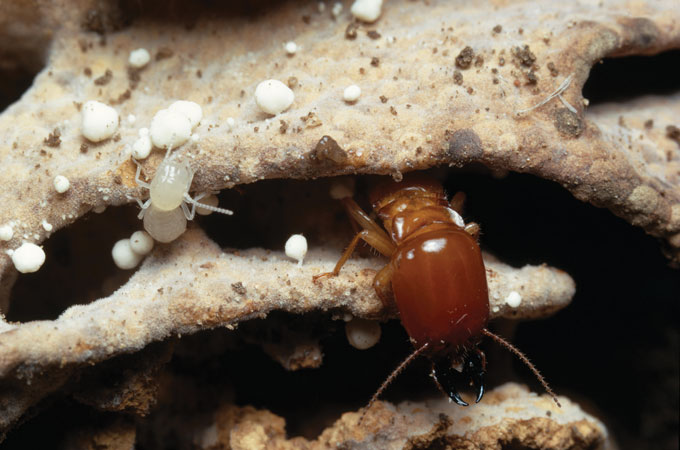 Macrotermes michaelseni termites in South Africa also took up farming, bringing home bits of dead plants to feed a fungus garden.Avalon/Photoshot License/Alamy Stock Photo
Macrotermes michaelseni termites in South Africa also took up farming, bringing home bits of dead plants to feed a fungus garden.Avalon/Photoshot License/Alamy Stock Photo 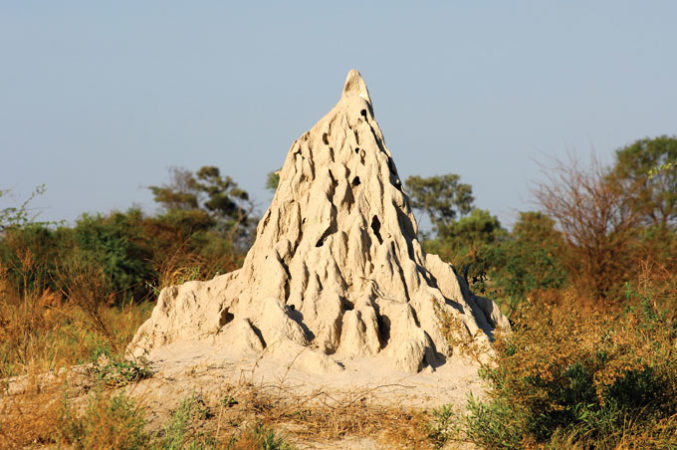 Macrotermes bellicosus colonies nourished by their fungal garden build large aboveground mounds with a hard exterior and sophisticated ventilation.GFC Collection/Alamy Stock Photo
Macrotermes bellicosus colonies nourished by their fungal garden build large aboveground mounds with a hard exterior and sophisticated ventilation.GFC Collection/Alamy Stock Photo
Some Atta ants live in the southern United States, however. So when I took a trip to Austin in January, Ulrich Mueller, a researcher who has spent decades studying fungus farmers at the University of Texas, offered to lead a mini-expedition to search for local leaf cutters.
I get my first glimpse of Atta texana about 10 steps into the main research building of the Brackenridge Field Laboratory. On a wall hangs a see-through teaching aid that resembles a two-story hamster palace with a tiny moving ant here and there. In one of the clear plastic boxes connected by walkway tubes lies what looks like an old gray bath sponge that really ought to be thrown out. Up close it seems more alien: irregular, micro-pocked, with zones of swampy dark brown fading to something close to pale flesh.
This fungal heap is why all those leaf haulers truck their green snippets in long lines on ant highways. The ants don’t eat the greenery. They poop on it, a pretreatment that encourages the fungal digestive enzymes. Then the ants deposit their little leaf confetti on the fungus heap to wait for lunch to grow.
“This is their stomach,” Mueller says. The fungal heap digests the greenery that the ants’ guts can’t. Feeding an ant nest full of fungus takes so much greenery that one nest of a South American Atta ant can become one of the neighborhood’s major plant eaters.
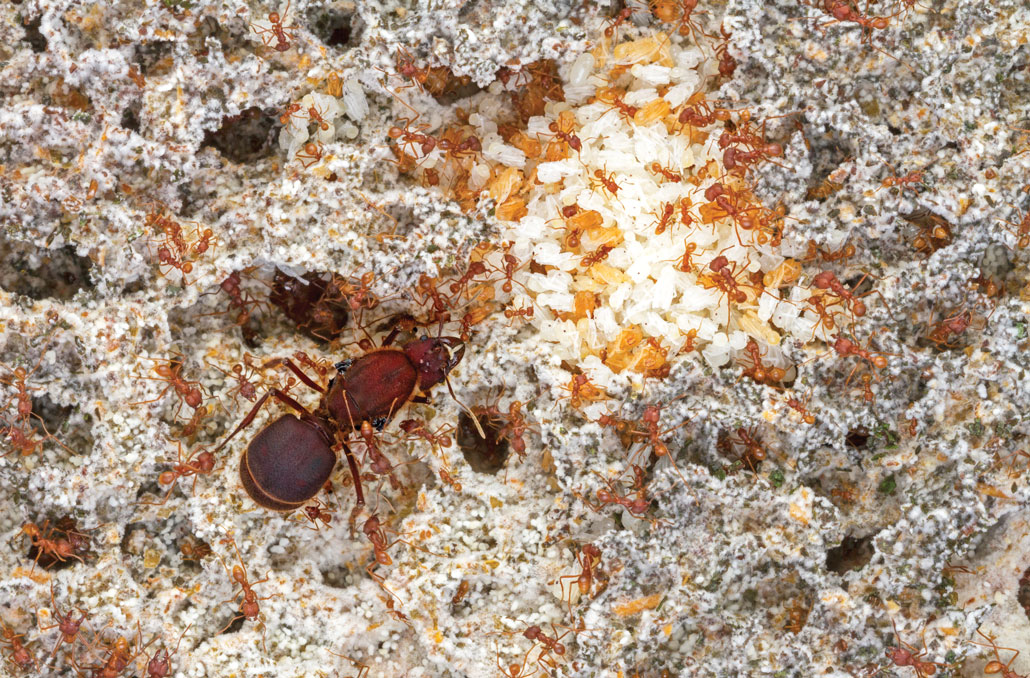 Leaf-cutter ants may be the most famous insect farmers. Atta texana ants (shown on their fungus) can provide most of the food for a colony with millions of ants.Alex Wild/Univ. of Texas at Austin
Leaf-cutter ants may be the most famous insect farmers. Atta texana ants (shown on their fungus) can provide most of the food for a colony with millions of ants.Alex Wild/Univ. of Texas at Austin
Protecting the crop
To a human, this great grazing fungal stomach appears too uniform for the ants’ own good. Each nest grows just one fungus clone, says Mueller, who has dug up bits, sampled, compared and resampled over the course of years. A human farm that grows only one or even two crop varieties invites disaster. If a pest or disease can crack the defenses of those few varieties, the whole crop is gone. Think Irish potato famine.
These ant species, however, have cultivated monocultures for millions of years. Some even use pesticides to fight a pest, swiping an invading fungus with a toxin secreted by Pseudonocardia bacteria, which thrive in an ant’s specialized pocket or body crease. Humans struggle with pests evolving resistance. For example, some Colorado potato beetles have evolved some resistance to 56 pest-killer ingredients. So how do ants keep their crops going?
For one thing, ants keep a close eye on their crops, catching and treating problems early. Mueller estimates that a farmer ant passes each bit of fungus in a garden multiple times a day. Humans call this micro-monitoring of crops “precision agriculture” and see its value for human farms too.
Also, ants may be ahead of humans in fostering beneficial microbiomes. The way ants transplant bits of garden to start a new patch could be one of the big differences between ant and human agriculture, Mueller says. Humans plant just the seed or the cutting. But when ants need to get some fungus going in a new spot, they nip out a chunk of the whole garden and move it — fungus plus whatever bazillion microbes are entangled.
The ants are replicating an entire microbial community, Mueller says. The ant farmers don’t need to know microbiology or anything except that a tuft of fungus tastes healthy. That way a microbial ensemble gets passed along that’s compatible with the crop and is a good mix against current menaces. “The ants figured out 60 million years ago … how important these interstitial microbes are,” Mueller says.

Sign Up For the Latest from Science News
Headlines and summaries of the latest Science News articles, delivered to your inbox
Client key* E-mail Address* Go
Thank you for signing up!
There was a problem signing you up.
Questionable practices
While Atta ants may manage their external gut’s microbiome admirably, some other ant farming practices look wasteful.
The fungus that Atta and some close relatives grow as their only crop is not super-efficient at breaking down compounds in the leaves. “It just takes the easy-to-digest stuff,” Mueller says. In turn, when the ants eat this fungus, they treat it more like an apple tree than like a window box of salad greens. Ants nip off the plump, pickable tidbits called gongylidia that fatten at the ends of strands of this particular fungus. Plenty of the rest of the fungus is wasted.
There are seemingly more efficient options. One ant species found at the Brackenridge Field Lab, in the Cyphomyrmex genus, tends pale yellow to amber chunks of yeast that the ants eat like grapes, without even seeds to spit into the trash. Plus these farmers don’t have to cut fresh leaves to feed the farm. Instead, the ants fertilize by bringing in an available waste product: caterpillar droppings.
The Atta ants’ efforts to collect so much greenery look inefficient by comparison. To explain the process up close, Mueller and grad student Tristan Kubik lead me out of the lab into the Brackenridge woods. This balmy, blue-sky January afternoon ought to be perfect for ants hauling leaves.
To find some foragers, Kubik, a third-generation insect enthusiast, stalks with the intensity of a cat. It takes me a minute to realize what he’s pointing at: little shreds of green that give the smallest irregular twitches. It’s like looking down at a few cupcake sprinkles on the floor, each giving just the tiniest jiggle per ant step, and all barely out of sync. These are leaf cutters carrying home their greenery.
The bitty jiggles are micro-steps, and the home nest is not even within human sight yet. Just one foraging trip that’s a middling distance from the nest, say 75 meters, could take about two hours round trip on smooth ground. These A. texana ants, however, venture twice as far. All that for just one sliver, maybe the size of a fingernail paring, of some leaf. The word that pops to mind is “ridiculous.”
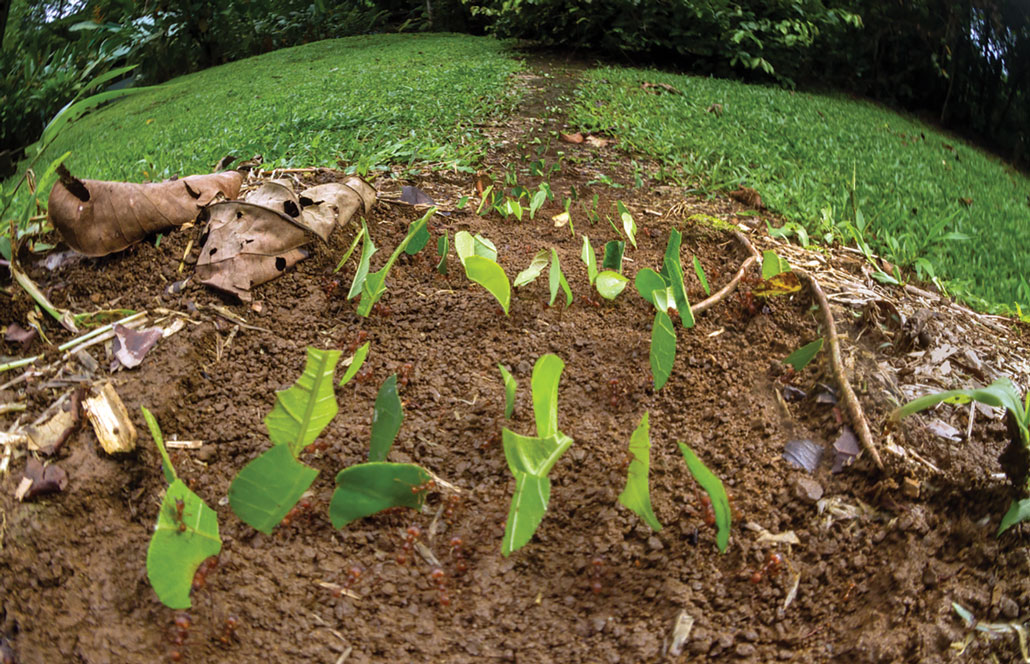 A lot of leaf snippets need to be cut off greenery and hauled home and then snipped some more to feed a giant fungal garden. Atta cephalotes ants will often clear a path to bring supplies to the nest.Alex Wild
A lot of leaf snippets need to be cut off greenery and hauled home and then snipped some more to feed a giant fungal garden. Atta cephalotes ants will often clear a path to bring supplies to the nest.Alex Wild
In human steps, the nest is just a several minutes’ stroll away. Nests look strangely undramatic viewed from above. The biggest one we see that afternoon lies on a gentle bank with a minor reddish splotch or two of soil erosion among gnarled winter trees. With coaching, I see several modest finger-poke–sized holes in the ground. I wonder how many thousands of ants might be toiling beneath our boots. Mueller debates with himself: “three million … maybe five?”
Cutting leaves into bits is a lot of work. To make tiny confetti out of one square meter of leaf surface means cutting back and forth and around a distance of 2.9 kilometers, researchers estimated in 2016 in Royal Society Open Science, after observing a lab colony of A. cephalotes. The energy that goes into feeding the farm sounds all too familiar.
Fungi as a crop don’t photosynthesize as plants do and so can’t make lunch out of sunlight. It might be more fair to compare a fungus farm not to a wheat field, but to cattle or pigs in human-run feedlots. Each calorie of food, be it slivers of leaf clippings or railroad cars of soy beans, needs to be grown or collected and then hauled in by farmers. Giant feedlots run by ants have the same relentless supply challenges that human ones do.
Look natural
It doesn’t surprise Ford Denison that some people see drawbacks in viewing ant farms as agricultural role models. Denison is author of the 2012 book Darwinian Agriculture, and he participated in the 2019 Konrad Lorenz symposium. At the University of Minnesota in St. Paul, Denison studies agricultural sustainability and thinks about how to strategically copy from nature.
Just because we see a farmlike marvel of an ant nest or a sustainable mixed-species forest doesn’t mean mimicking its full form would be a great idea. The thing to do, he says, is to look for the details that evolution has tested for millions of years against other options.
Evolution certainly did not test the monoculture form of ant nests through competition. The ants can’t grow their fungus any other way. If there’s more than one strain of fungus in a farm, “there’s chemical warfare,” he says. One strain typically kills its rival, even if they’re growing in separate chambers.
“Their long-term use of monoculture may be evidence that monoculture can be sustainable,” Denison says. Humans looking for natural models, however, should probably aim for a higher bar. Monoculture farming among these ants “certainly doesn’t mean that it’s better than polyculture,” he says. Cultivating more diverse farms might have eased pest problems. But who knows? Ants with one crop never competed against ants with more than one.
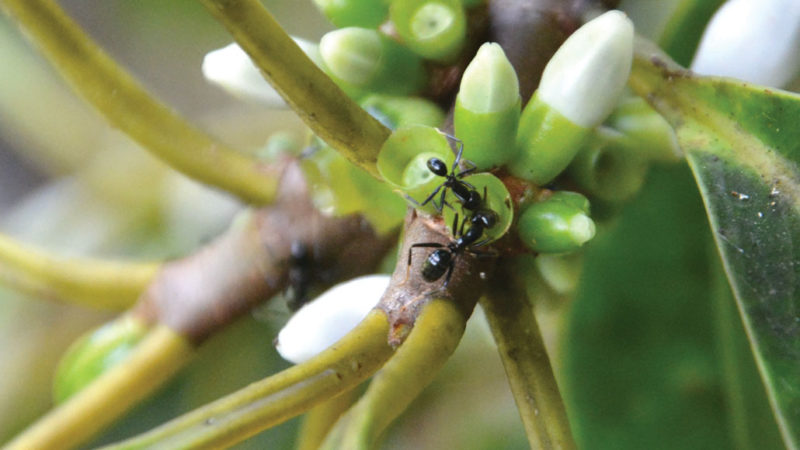 Small ants plant seeds and cultivate the flowery Squamellaria species for shelter plus sweet floral feasts.G. Chomicki
Small ants plant seeds and cultivate the flowery Squamellaria species for shelter plus sweet floral feasts.G. Chomicki
Back to the trees
Other insect farms certainly have quirks that look as if they evolved under intense competition. Consider the treetop Squamellaria blobs, which face challenges in recycling nitrogen.
Nitrogen is often a precious commodity for plants like Squamellaria that don’t live in soil. For these plants, which have forged a space station lifestyle clinging to tree branches high above the ground, the P. nagasau ants may be cherished deliverers of nitrogen or other nutrients. The ants also offer vital defense, rushing to attack intruders that try to nibble a seed or a leaf from their bulbous farms.
As payback, the plant offers absolutely necessary shelter for the ants and food that’s convenient but replaceable in a pinch. The flowers of Squamellaria plants hold a sweet appeal for ants. When the petals fall off, the flower pauses in development for days, and ants visit to feed on a sugary rim with a shot of amino acids at the flower base.
In six Squamellaria species, as the plants grow and open more entrances to their inner cavities, the ants move in through tiny doorways and raise young. A large plant can host around 10,000 ants, and a whole ant colony can expand its boundaries to embrace multiple plants, even a mix of lumpy species.
In the plants’ bases, some chambers form smooth inner walls while other cavities sprout widely spaced little knobs. Ants tend eggs and larvae in the smooth-sided chambers. The knobby-walled cavities, Chomicki thinks, serve as ant latrines and garbage dumps. From the plant point of view, these chambers serve as donation centers for nitrogen-rich ant excretions.
The knobby walls’ uptake of nitrogen is “very, very efficient,” Chomicki says. He has injected different concentrations and tracked plants keeping up with massive influxes.
Ants check all the boxes for truly farming in the six species, Chomicki argues. He has videotaped ants planting Squamellaria seeds by tucking them under tree bark. Ants then defend the seeds from leaf beetles and other predators, even attacking inquisitive scientists. This vigorous defense in the treetop world could count as yet another chore in tending the farm.
“The ants are directly consuming food they fertilize with their feces,” says one of Chomicki’s coauthors, ecologist Toby Kiers of Vrije Universiteit Amsterdam. Fertilizer pollution is a hot topic in the Netherlands. In Kiers’ vision of a more sustainable future, field crops get their fertilizer from the manure in neighboring pastures, so a former waste product circles back into something useful.
Take inspiration from the ants, she urges. A blob farm is “like the ultimate circular economy.”

